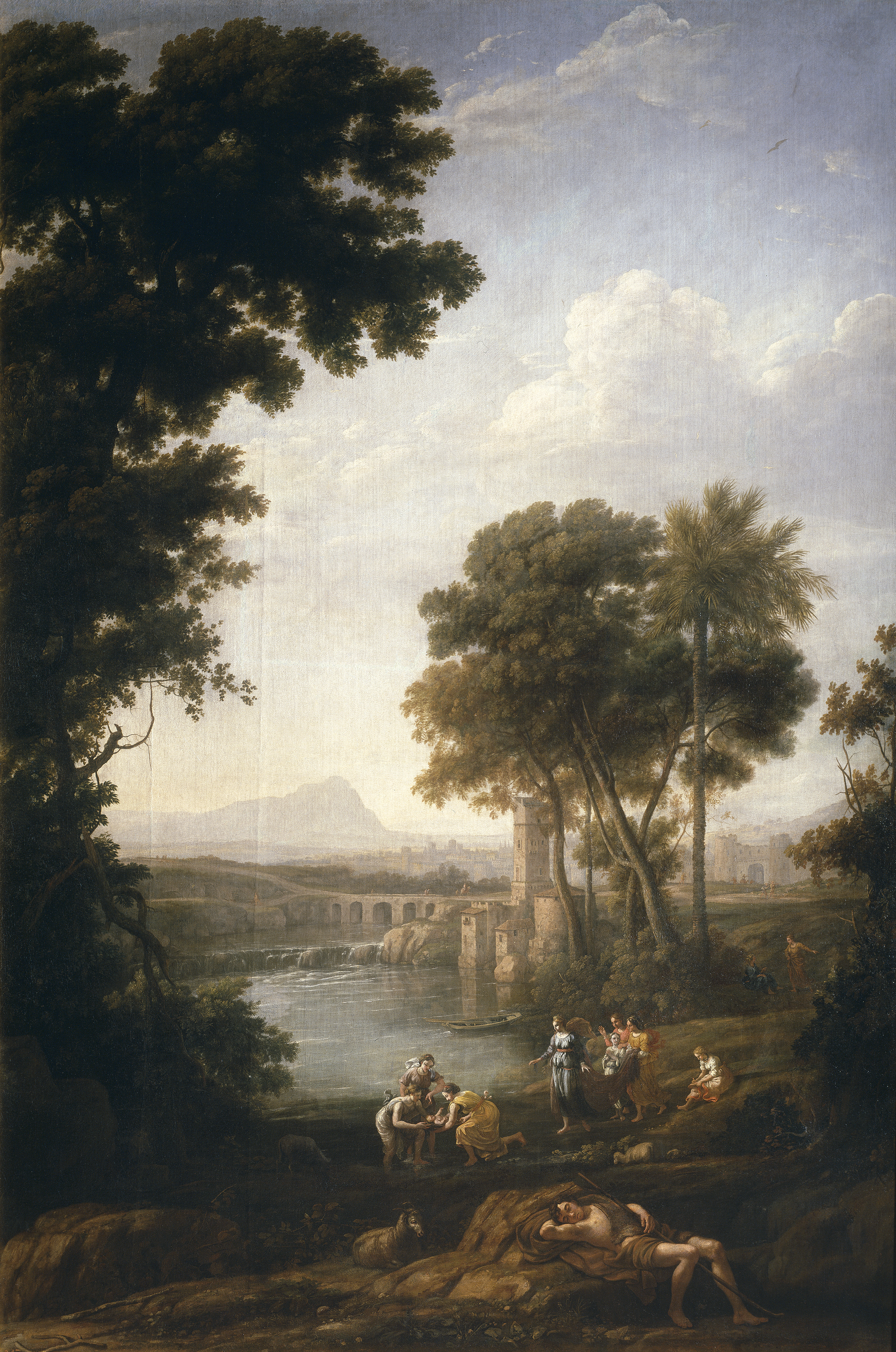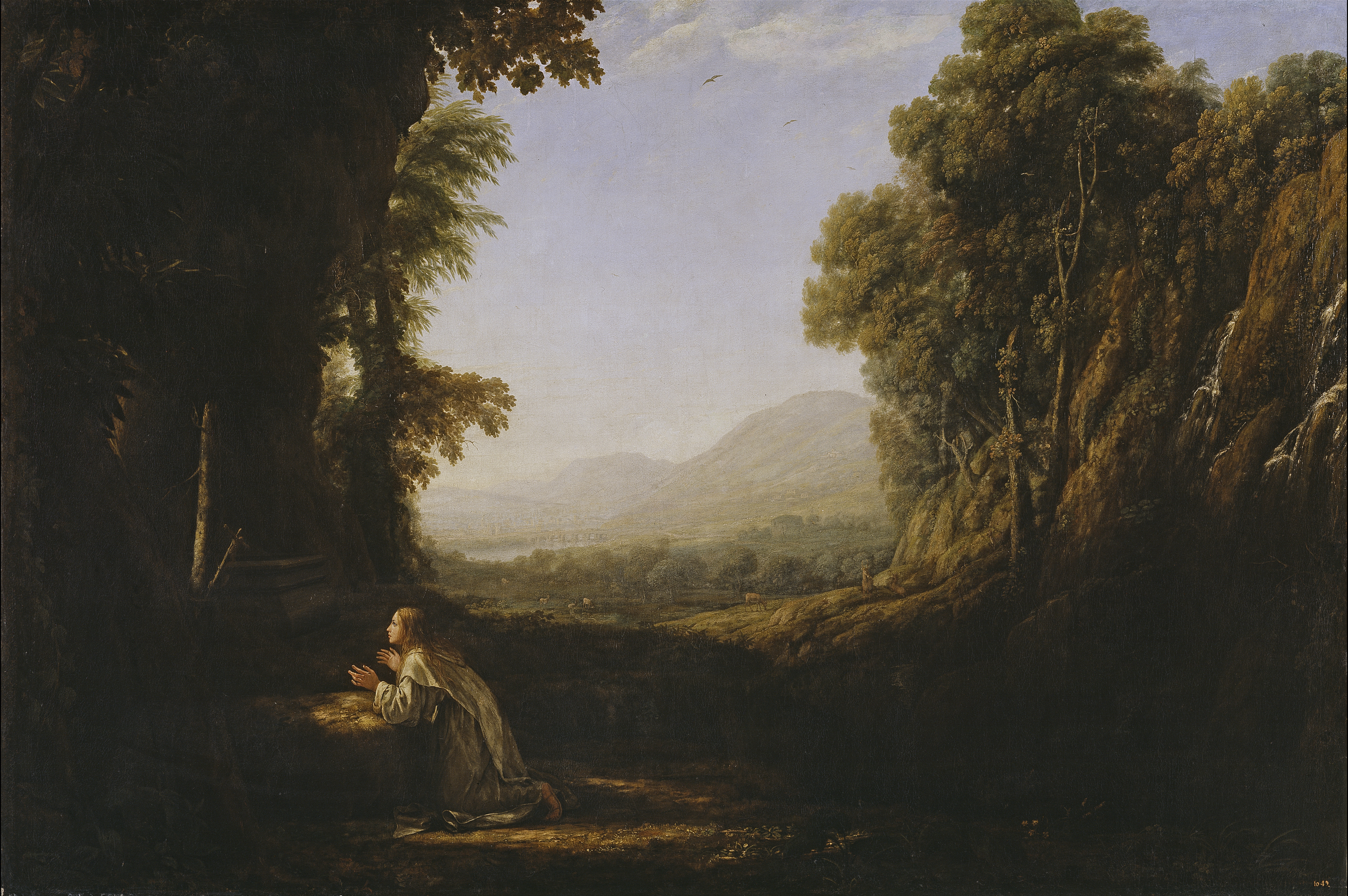|
Landscape With St Paula Of Rome Embarking At Ostia
''Landscape with Saint Paula of Rome Embarking at Ostia'' or ''The Embarkation of Saint Paula'' is an oil-on-canvas painting by Claude Lorrain. It was painted in 1639–1640 as one of a series of works commissioned by Philip IV of Spain for a gallery of landscapes at the Palacio del Buen Retiro – he also commissioned works from Nicolas Poussin, Herman van Swanevelt, Jan Both, Gaspard Dughet and Jean Lemaire. It is now in the Museo del Prado in Madrid. The series Lorrain produced for the Palacio del Buen Retiro included four in horizontal format, completed during 1635–1638 ('' Landscape with the Temptation of St Anthony'', ''Landscape with St Onuphrius'', '' Landscape with St María de Cervelló'' and a lost work) and four in a vertical format, completed during 1639–1641 ('' Landscape with Tobias and Raphael'', ''Landscape with Saint Paula of Rome Embarking at Ostia'', '' Landscape with the Finding of Moses'' and ''Landscape with the Burial of St Serapia''). The theme of sai ... [...More Info...] [...Related Items...] OR: [Wikipedia] [Google] [Baidu] |
Landscape With Tobias And Raphael
''Landscape with Tobias and Raphael'' is a 1639-40 painting by Claude Lorrain, one of a series of paintings commissioned from the artist for the Palacio del Buen Retiro and now in the Prado Museum The Prado Museum ( ; ), officially known as Museo Nacional del Prado, is the main Spanish national art museum, located in central Madrid. It is widely considered to house one of the world's finest collections of European art, dating from the ... in Madrid. References {{17C-painting-stub category:1640 paintings category:Paintings by Claude Lorrain category:Landscape paintings Paintings in the Museo del Prado by French artists Paintings of Raphael (archangel) Paintings depicting Tobias ... [...More Info...] [...Related Items...] OR: [Wikipedia] [Google] [Baidu] |
Landscape Paintings
Landscape painting, also known as landscape art, is the depiction of natural scenery such as mountains, valleys, trees, rivers, and forests, especially where the main subject is a wide view—with its elements arranged into a coherent composition. In other works, landscape backgrounds for figures can still form an important part of the work. Sky is almost always included in the view, and weather is often an element of the composition. Detailed landscapes as a distinct subject are not found in all artistic traditions, and develop when there is already a sophisticated tradition of representing other subjects. Two main traditions spring from Western painting and Chinese art, going back well over a thousand years in both cases. The recognition of a spiritual element in landscape art is present from its beginnings in East Asian art, drawing on Daoism and other philosophical traditions, but in the West only becomes explicit with Romanticism. Landscape views in art may be entirely i ... [...More Info...] [...Related Items...] OR: [Wikipedia] [Google] [Baidu] |
Paintings By Claude Lorrain
Painting is the practice of applying paint, pigment, color or other medium to a solid surface (called the "matrix" or "support"). The medium is commonly applied to the base with a brush, but other implements, such as knives, sponges, and airbrushes, can be used. In art, the term ''painting ''describes both the act and the result of the action (the final work is called "a painting"). The support for paintings includes such surfaces as walls, paper, canvas, wood, glass, lacquer, pottery, leaf, copper and concrete, and the painting may incorporate multiple other materials, including sand, clay, paper, plaster, gold leaf, and even whole objects. Painting is an important form in the visual arts, bringing in elements such as drawing, composition, gesture (as in gestural painting), narration (as in narrative art), and abstraction (as in abstract art). Paintings can be naturalistic and representational (as in still life and landscape painting), photographic, abstract, narrative, sy ... [...More Info...] [...Related Items...] OR: [Wikipedia] [Google] [Baidu] |
1640 Paintings
Year 164 (Roman numerals, CLXIV) was a leap year starting on Saturday (link will display the full calendar) of the Julian calendar. At the time, it was known as the Year of the Consulship of Macrinus and Celsus (or, less frequently, year 917 ''Ab urbe condita''). The denomination 164 for this year has been used since the early medieval period, when the Anno Domini calendar era became the prevalent method in Europe for naming years. Events By place Roman Empire * Emperor Marcus Aurelius gives his daughter Lucilla in marriage to his co-emperor Lucius Verus. * Avidius Cassius, one of Lucius Verus' generals, crosses the Euphrates and invades Parthia. * Ctesiphon is captured by the Roman empire, Romans, but returns to the Parthians after the end of the war. * The Antonine Wall in Scotland is abandoned by the Romans. * Seleucia on the Tigris is destroyed. Births * Bruttia Crispina, Roman empress (d. 191) * Ge Xuan (or Xiaoxian), Chinese Taoism, Taoist (d. 244) * Yu Fan, C ... [...More Info...] [...Related Items...] OR: [Wikipedia] [Google] [Baidu] |
Gaspar De Guzmán, Count-Duke Of Olivares
Gaspar de Guzmán y Pimentel, 1st Duke of Sanlúcar, 3rd Count of Olivares, GE, known as the Count-Duke of Olivares (taken by joining both his countship and subsequent dukedom) (6 January 1587 – 22 July 1645), was a Spanish royal favourite ( es, valido) of Philip IV and minister. Appointed as Grandee on 10 April 1621, a day after the ending of the Twelve Years' Truce to January 1643, he over-exerted Spain in foreign affairs and unsuccessfully attempted domestic reform. His policy of committing Spain to recapture Holland led to a renewal of the Eighty Years' War while Spain was also embroiled in the Thirty Years' War (1618–1648). In addition, his attempts to centralise power and increase wartime taxation led to revolts in Catalonia and in Portugal, which brought about his downfall. Rise to power Olivares was born in Rome in 1587, where his father, Enrique de Guzmán, 2nd Count of Olivares, from one of Spain's oldest noble families,Elliot, 1991, p. 8. was the Spani ... [...More Info...] [...Related Items...] OR: [Wikipedia] [Google] [Baidu] |
Ostia (Rome)
Ostia (, ; officially Lido di Ostia) is a large neighbourhood in the X Municipio of the ''comune'' of Rome, Italy, near the ancient port of Rome, which is now a major archaeological site known as Ostia Antica. Ostia is also the only or district of Rome on the Tyrrhenian Sea, and many Romans spend the summer holidays there. History Ostia Antica had been the port city of ancient Rome, and is often referenced in writings from the times of the Roman Republic and the Roman Empire. For Christian posterity, Ostia Antica was especially important as the site of the death of Saint Monica (mother of Saint Augustine) in 387 in a house property of the Diocesi of Rome, on their way back to Africa after Augustine's conversion to Christianity. An important stand in Italian nationalism of the 19th century was a veneration for the glories of the Roman past, manifested in a wish to revive or recreate various places and institutions connected with Ancient Rome. In 1871, the city of Rome became ... [...More Info...] [...Related Items...] OR: [Wikipedia] [Google] [Baidu] |
Paula Of Rome
Paula of Rome (AD 347–404) was an ancient Roman saint and early Desert Mother. A member of one of the richest senatorial families which claimed descent from Agamemnon, Paula was the daughter of Blesilla and Rogatus, from the great clan of the Furii Camilli.T. S. M. Mommaerts & D. H. Kelley, ''The Anicii of Gaul and Rome'', in ''Fifth-century Gaul: a Crisis of Identity?'', ed. by John Drinkwater and Hugh Elton, (Cambridge University Press, Cambridge & New York, 1992) Pages 120-121. At the age of 16, Paula was married to the nobleman Toxotius, with whom she had four daughters, Blaesilla, Paulina, Eustochium, and Rufina. She also had a boy, also named Toxotius. Life Information about Paula's early life is recorded by Jerome. In his Letter 108, he states that she had led a luxurious life and held a great status. She dressed in silks, and had been carried about the city by her eunuch slaves. Entering the religious life At the age of 32, Paula was widowed. She continued to dedic ... [...More Info...] [...Related Items...] OR: [Wikipedia] [Google] [Baidu] |
Landscape With The Burial Of St Serapia
''Landscape with the Burial of St. Serapia'' is a 1639–40 painting by Claude Lorrain, one of several commissioned from the artist by Philip IV of Spain and now in the Prado Museum. it shows the burial of Saint Serapia, slave to Saint Sabina – the lid of the sarcophagus is shown with the inscription ''SEPVLTVRA.S.SABIN (a)... SEPELIR(e) IVBET.C.SANCTAE SERAPI(ae)''. Her martyrdom occurred in Vindena, now known to have been sited near Terni, although at the time the painting was produced it was thought to be located on the Aventine Hill The Aventine Hill (; la, Collis Aventinus; it, Aventino ) is one of the Seven Hills on which ancient Rome was built. It belongs to Ripa, the modern twelfth ''rione'', or ward, of Rome. Location and boundaries The Aventine Hill is the sou ... (hence the Basilica of Santa Sabina). {{17C-painting-stub category:Landscape paintings category:1640 paintings category:Paintings by Claude Lorrain category:Paintings of the Museo del Pra ... [...More Info...] [...Related Items...] OR: [Wikipedia] [Google] [Baidu] |
Landscape With The Finding Of Moses ...
''Landscape with the Finding of Moses'' is an oil painting on canvas of 1639–40 by Claude Lorrain, one of a series commissioned from the artist by Philip IV of Spain for the Palacio del Buen Retiro. It is now in the collection of the Museo del Prado. References {{17C-painting-stub Paintings by Claude Lorrain Paintings in the Museo del Prado by French artists 1640 paintings Landscape paintings Lorrain Lorrain may refer to: * Claude Lorrain (1600–82), a 17th-century French artist of the baroque style * Lorrain language, a Romance dialect spoken in Lorraine region in France and Gaume region in Belgium See also * Lorain (other) * Lora ... [...More Info...] [...Related Items...] OR: [Wikipedia] [Google] [Baidu] |
Landscape With St María De Cervelló
''Landscape with St María de Cervelló'' is a 1637 painting by Claude Lorrain, an early work from a series commissioned from the artist by Philip IV of Spain for the palacio del Buen Retiro. It is now in the Prado Museum The Prado Museum ( ; ), officially known as Museo Nacional del Prado, is the main Spanish national art museum, located in central Madrid. It is widely considered to house one of the world's finest collections of European art, dating from the ... in Madrid. It shows the eponymous saint praying in the left foreground. References {{17C-painting-stub Paintings by Claude Lorrain 1637 paintings Landscape paintings Paintings in the Museo del Prado by French artists ... [...More Info...] [...Related Items...] OR: [Wikipedia] [Google] [Baidu] |
Claude Lorrain
Claude Lorrain (; born Claude Gellée , called ''le Lorrain'' in French; traditionally just Claude in English; c. 1600 – 23 November 1682) was a French painter, draughtsman and etcher of the Baroque era. He spent most of his life in Italy, and is one of the earliest important artists, apart from his contemporaries in Dutch Golden Age painting, to concentrate on landscape painting. His landscapes are usually turned into the more prestigious genre of history paintings by the addition of a few small figures, typically representing a scene from the Bible or classical mythology. By the end of the 1630s he was established as the leading landscapist in Italy, and enjoyed large fees for his work. His landscapes gradually became larger, but with fewer figures, more carefully painted, and produced at a lower rate.Kitson, 6 He was not generally an innovator in landscape painting, except in introducing the sun and streaming sunlight into many paintings, which had been rare befor ... [...More Info...] [...Related Items...] OR: [Wikipedia] [Google] [Baidu] |








